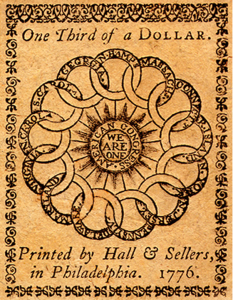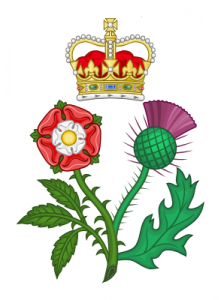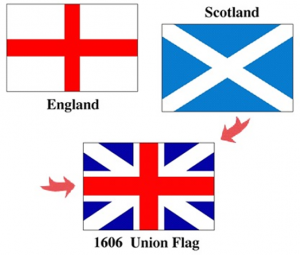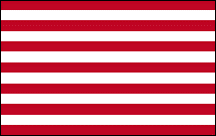Flags May Have Inspired the American Union
Independence Day is celebrated each year on July Fourth, and the date’s number is used to name the celebration itself, more so perhaps, than the holiday’s official name. The Fourth celebrates the Declaration of Independences’ formal adoption in 1776, and the Declaration justifies & explains the “causes which [impelled] them to the separation.”
 Nevertheless, there are other important things which the Declaration accomplished. Not only did the document establish the nation’s birth date, but it christened the new nation as the United States of America. This was and is significant because the name identifies one of the nation’s core values. “United” is the key word, and the American union was forged during the American Revolution, shaped on the anvil of war during the War of 1812, and tempered during the U.S. Civil War. During years of peace, the United States has enjoyed prosperity in years of plenty while struggling through times of economic hardship. Growth, expansion and trials have matured our nation. Over two centuries of experiences have sharpened the blade first forged in 1776.
Nevertheless, there are other important things which the Declaration accomplished. Not only did the document establish the nation’s birth date, but it christened the new nation as the United States of America. This was and is significant because the name identifies one of the nation’s core values. “United” is the key word, and the American union was forged during the American Revolution, shaped on the anvil of war during the War of 1812, and tempered during the U.S. Civil War. During years of peace, the United States has enjoyed prosperity in years of plenty while struggling through times of economic hardship. Growth, expansion and trials have matured our nation. Over two centuries of experiences have sharpened the blade first forged in 1776.
Before the Civil War, Americans spoke of their country using plural verbs as for example, “The United States are….” They considered themselves to be Virginians, Texans or Nebraskans first and Americans second. After the Civil War, Americans began to say, “The United States is….” while seeing themselves first as Americans and then as residents of their home states.
 Symbolism of union, which were found in early flags of the America’s history predate independence declared in 1776. In 1603, King James VI of Scotland ascended the English throne as King James I and created a union of crowns: two separate kingdoms united by one king. A floral emblem of this union combined the English Rose with the Scottish thistle with both displayed under a crown that united the two realms. A flag—the first Union Jack—was created in 1606 to symbolize that union. Scotland and England followed the example of their union flag by uniting politically as Great Britain one years later. Great Britain’s Union Flag flew over the British North American Colonies suggesting the importance of political union to the American colonists. When the armed resistance began these colonists fought to demand their rights as British subjects, and they displayed union flags of thirteen red and white stripes with the British Union Jack added in the upper corner next to the staff showing that they still felt loyalty to their king.
Symbolism of union, which were found in early flags of the America’s history predate independence declared in 1776. In 1603, King James VI of Scotland ascended the English throne as King James I and created a union of crowns: two separate kingdoms united by one king. A floral emblem of this union combined the English Rose with the Scottish thistle with both displayed under a crown that united the two realms. A flag—the first Union Jack—was created in 1606 to symbolize that union. Scotland and England followed the example of their union flag by uniting politically as Great Britain one years later. Great Britain’s Union Flag flew over the British North American Colonies suggesting the importance of political union to the American colonists. When the armed resistance began these colonists fought to demand their rights as British subjects, and they displayed union flags of thirteen red and white stripes with the British Union Jack added in the upper corner next to the staff showing that they still felt loyalty to their king.
 Later, the struggle was found not to be with Parliament alone, but with the king also. After colonists declared independence, the king’s union jack was replaced with a new union, a constellation of thirteen white stars displayed against a blue field thus again representing the key concept of Union.
Later, the struggle was found not to be with Parliament alone, but with the king also. After colonists declared independence, the king’s union jack was replaced with a new union, a constellation of thirteen white stars displayed against a blue field thus again representing the key concept of Union.
When the Declaration of Independence was adopted, John Adams explained the importance of union. Thirteen colonies that were diverse in their geography, their population, their agriculture, their manufacturing, their customs and their religion—and yet they united to form on nation. Adams noted that achieving union was like synchronizing a room full of clocks—
Thirteen Clocks were made to strike together: a perfect mechanism which no
artist had ever before effected.
Union Flag of 13 Colonies Continental Union Flag 13 Star United States Flag
With the Declaration of Independence, thirteen “free and independent states” banded together in a common cause resulting in a political union that has withstood the challenges of more than two centuries.
The current U.S. flag still shows thirteen red and white stripes, which symbolize the union of thirteen British American Colonies that declared independence and created the United States of America. The union of thirteen stars, however, has grown to fifty in representation of fifty diverse states stretching from New England to the West Coast. Despite differences, which are greater that those found in the first thirteen states, the union remains so strong that none seriously question it. Additionally, each state encompasses a diversity of peoples and cultures, and like John Adams room full of clocks, it takes great effort to keep them synchronized.
Three cheers for the Red, White & Blue symbolizing America’s independence and union.



